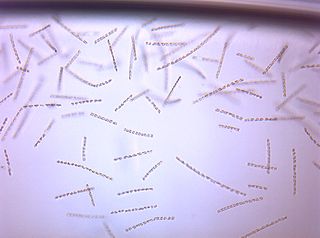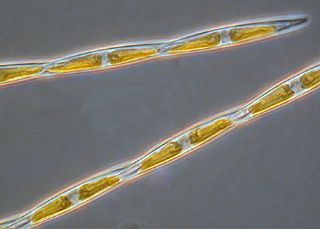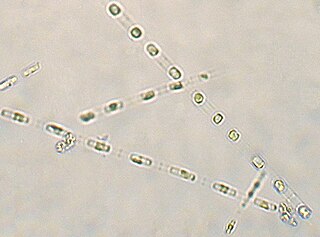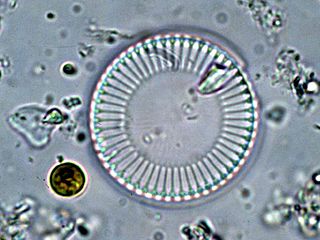Related Research Articles

A diatom is any member of a large group comprising several genera of algae, specifically microalgae, found in the oceans, waterways and soils of the world. Living diatoms make up a significant portion of the Earth's biomass: they generate about 20 to 50 percent of the oxygen produced on the planet each year, take in over 6.7 billion tonnes of silicon each year from the waters in which they live, and constitute nearly half of the organic material found in the oceans. The shells of dead diatoms can reach as much as a half-mile deep on the ocean floor, and the entire Amazon basin is fertilized annually by 27 million tons of diatom shell dust transported by transatlantic winds from the African Sahara, much of it from the Bodélé Depression, which was once made up of a system of fresh-water lakes.

Psychrophiles or cryophiles are extremophilic organisms that are capable of growth and reproduction in low temperatures, ranging from −20 °C (−4 °F) to 20 °C (68 °F). They are found in places that are permanently cold, such as the polar regions and the deep sea. They can be contrasted with thermophiles, which are organisms that thrive at unusually high temperatures, and mesophiles at intermediate temperatures. Psychrophile is Greek for 'cold-loving', from Ancient Greek ψυχρός (psukhrós) 'cold, frozen'.
Auxospores are specialised cells in diatoms that are produced at key stages in their cell cycle or life history. Auxospores typically play a role in growth processes, sexual reproduction or dormancy.

Thalassiosira pseudonana is a species of marine centric diatoms. It was chosen as the first eukaryotic marine phytoplankton for whole genome sequencing. T. pseudonana was selected for this study because it is a model for diatom physiology studies, belongs to a genus widely distributed throughout the world's oceans, and has a relatively small genome at 34 mega base pairs. Scientists are researching on diatom light absorption, using the marine diatom of Thalassiosira. The diatom requires a high enough concentration of CO2 in order to utilize C4 metabolism (Clement et al. 2015).

Chaetoceros is a genus of diatoms in the family Chaetocerotaceae, first described by the German naturalist C. G. Ehrenberg in 1844. Species of this genus are mostly found in marine habitats, but a few species exist in freshwater. It is arguably the common and most diverse genus of marine planktonic diatoms, with over 200 accepted species. It is the type genus of its family.
Grethe Berit Rytter Hasle was a Norwegian planktologist. Among the first female professors of natural science at the University of Oslo, she specialized in the study of phytoplankton.

Pseudo-nitzschia is a marine planktonic diatom genus that accounts for 4.4% of pennate diatoms found worldwide. Some species are capable of producing the neurotoxin domoic acid (DA), which is responsible for the neurological disorder in humans known as amnesic shellfish poisoning (ASP). Currently, 58 species are known, 28 of which have been shown to produce DA. It was originally hypothesized that only dinoflagellates could produce harmful algal toxins, but a deadly bloom of Pseudo-nitzschia occurred in 1987 in the bays of Prince Edward Island, Canada, and led to an outbreak of ASP. Over 100 people were affected by this outbreak after consuming contaminated mussels; three people died. Since this event, no additional deaths have been attributed to ASP, though the prevalence of toxic diatoms and DA has increased worldwide. This anomaly is likely due to increased awareness of harmful algal blooms (HABs) and their implications for human and ecosystem health.
Chaetoceros pseudocurvisetus is a marine diatom in the genus Chaetoceros. It is an important primary producer in the oceans. C. pseudocurvisetus forms resting spores and resting cells, particularly in the absence of essential nutrients.

Ditylum brightwellii is a species of cosmopolitan marine centric diatoms. It is a unicellular photosynthetic autotroph that has the ability to divide rapidly and contribute to spring phytoplankton blooms.
Thalassiosira symmetrica is a species of marine centric diatoms. It differs with T. eccentrica in the value processes and distribution patterns. The latter species is more abundant in inshore waters, while T. symmetrica has been found in oceanic waters.

The carbonic anhydrases form a family of enzymes that catalyze the interconversion between carbon dioxide and water and the dissociated ions of carbonic acid. The active site of most carbonic anhydrases contains a zinc ion. They are therefore classified as metalloenzymes. The enzyme maintains acid-base balance and helps transport carbon dioxide.
Dissimilatory nitrate reduction to ammonium (DNRA), also known as nitrate/nitrite ammonification, is the result of anaerobic respiration by chemoorganoheterotrophic microbes using nitrate (NO3−) as an electron acceptor for respiration. In anaerobic conditions microbes which undertake DNRA oxidise organic matter and use nitrate (rather than oxygen) as an electron acceptor, reducing it to nitrite, and then to ammonium (NO3− → NO2− → NH4+).

Thalassiosira is a genus of centric diatoms, comprising over 100 marine and freshwater species. It is a diverse group of photosynthetic eukaryotes that make up a vital part of marine and freshwater ecosystems, in which they are key primary producers and essential for carbon cycling

Skeletonema is a genus of diatoms in the family Skeletonemataceae. It is the type genus of its family. The genus Skeletonema was established by R. K. Greville in 1865 for a single species, S. barbadense, found in the Barbados deposit [Jung 2009]. These diatoms are photosynthetic organisms, meaning they obtain carbon dioxide from their surrounding environment and produce oxygen along with other byproducts. Reproduce sexually and asexually [Guiry 2011]. Skeletonema belong to the morphological category referred to as centric diatoms. These are classified by having valves with radial symmetry and the cells lack significant motility [Horner 2002]. Skeletonema are cylindrical shaped with a silica frustule. Cells are joined by long marginal processes to form a filament [Horner 2002]. Their length ranges from 2-61 micrometers, with a diameter ranging from 2-21 micrometers [Hasle 1997]. They are found typically in the neritic zone of the ocean and are highly populous in coastal systems [Jung 2009]. The genus is considered cosmopolitan, showing a wide range of tolerance for salinity and temperature [Hasle 1973]. For example, they have been found in various aquatic environments such as brackish or freshwater. Skeletonema are found worldwide excluding Antarctic waters [Hevia-Orube 2016]. Some harmful effects these diatoms may have on an ecosystem are attributed to large blooming events which may cause hypoxic events in coastal systems. Additionally, they are known to cause water discoloration [Kraberg 2010].

Cyclotella is a genus of diatoms often found in oligotrophic environments, both marine and fresh water. It is in the family Stephanodiscaceae and the order Thalassiosirales. The genus was first discovered in the mid-1800s and since then has become an umbrella genus for nearly 100 different species, the most well-studied and the best known being Cyclotella meneghiniana. Despite being among the most dominant genera in low-productivity environments, it is relatively understudied.

Marine protists are defined by their habitat as protists that live in marine environments, that is, in the saltwater of seas or oceans or the brackish water of coastal estuaries. Life originated as marine single-celled prokaryotes and later evolved into more complex eukaryotes. Eukaryotes are the more developed life forms known as plants, animals, fungi and protists. Protists are the eukaryotes that cannot be classified as plants, fungi or animals. They are mostly single-celled and microscopic. The term protist came into use historically as a term of convenience for eukaryotes that cannot be strictly classified as plants, animals or fungi. They are not a part of modern cladistics because they are paraphyletic.
Carbonyl sulfide hydrolase (EC 3.13.1.7; abbreviated as COSase) is an enzyme that degrades carbonyl sulfide (COS) to hydrogen sulfide (H2S) and carbon dioxide (CO2). Isolated from Thiobacillus thioparus bacterium, the potential of COSase would reduce the high global warming effect of COS and change the ozone chemistry, because COS is the source of sulfur in the troposphere.

The cadmium cycle is a biogeochemical cycle of dispersion and deposition of cadmium through the atmosphere, biosphere, pedosphere, and hydrosphere. Cadmium typically exists in the environment with an oxidation state of +2 but can be found with an oxidation state of +1.
Greta Albrecht Fryxell was a marine scientist known for her work on the biology and taxonomy of diatoms. In 1996, she was elected a fellow of the American Association for the Advancement of Science.

Skeletonema costatum is a cosmopolitan centric diatom that belongs to the genus Skeletonema. It was first described by R. K. Greville, who originally named it Melosira costata, in 1866. It was later renamed by Cleve in 1873 and was more narrowly defined by Zingone et al. and Sarno et al. Skeletonemacostatum is the most well known species of the genus Skeletonema and is often one of the dominant species responsible for red tide events.
References
- 1 2 Thalassiosira weissflogii (Grunow) G.Fryxell & Hasle, 1977 World Register of Marine Species. Retrieved 2011-11-18.
- 1 2 3 4 5 Thalassiosira weissflogii (Grunow) G. Fryxell & Hasle, (1896) 1977 USGS. Retrieved 2011-11-18.
- ↑ Roberts, K.; Granum, E.; Leegood, R. C.; Raven, J. A. (20 July 2007). "C3 and C4 Pathways of Photosynthetic Carbon Assimilation in Marine Diatoms Are under Genetic, Not Environmental, Control". Plant Physiology. 145 (1): 230–235. doi:10.1104/pp.107.102616. PMC 1976569 . PMID 17644625.
- ↑ Sorhannus Ulf; Ortiz JD; Wolf M; Fox MG. (2010). "Microevolution and speciation in Thalassiosira weissflogii (Bacillariophyta)". Protist. 161 (2): 237–249. doi:10.1016/j.protis.2009.10.003. PMID 20018562.
- 1 2 TW1200 Archived 2011-11-29 at the Wayback Machine Reed Mariculture Inc. Retrieved 2011-11-18.
- ↑ Vrieling, E. G.; Poort, L.; Beelen, T. P. M.; Gieskes, W. W. C. (1999). "Growth and silica content of the diatoms Thalassiosira weissflogii and Navicula salinarum at different salinities and enrichments with aluminium". European Journal of Phycology. 34 (3): 307–316. doi: 10.1017/s0967026299002206 .
- ↑ Ishida, Y., N. Hiragushi, H. Kitaguchi, A. Mitsutani, S. Nagai, and M. Yoshimura. 2000. A highly CO2-tolerant diatom, Thalassiosira weissflogi H1, enriched from coastal sea, and its fatty acid composition. Fisheries Science (Tokyo) 66(4):655-659.
- ↑ Lee, J. G.; Roberts, S. B.; Morel, F. M. M. (1995). "Cadmium: a nutrient for the marine diatom Thalassiosira weissflogii". Limnology and Oceanography. 40 (6): 1056–1063. Bibcode:1995LimOc..40.1056L. doi:10.4319/lo.1995.40.6.1056.
- ↑ Sala, S. E. 1997. Diatom flora of Paso de las Piedras impounding, Buenos Aires Province IV: Order Centrales. Gayana. Botánica 54(1):1-14.
- ↑ Lane TW, Saito MA, George GN, Pickering IJ, Prince RC, Morel FM (May 2005). "Biochemistry: a cadmium enzyme from a marine diatom". Nature. 435 (7038): 42. Bibcode:2005Natur.435...42L. doi: 10.1038/435042a . PMID 15875011.
- "The First Cadmium Enzyme – Carbonic Anhydrase 2 from the marine diatom Thalassiosira weissflogii". SSRL Science Highlight. 26 May 2005.
- ↑ Armbrust, E. V. (1999). "Identification of a new gene family expressed during the onset of sexual reproduction in the centric diatom Thalassiosira weissflogii". Applied and Environmental Microbiology. 65 (7): 3121–3128. Bibcode:1999ApEnM..65.3121A. doi: 10.1128/AEM.65.7.3121-3128.1999 . PMC 91465 . PMID 10388712.